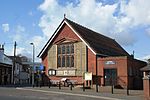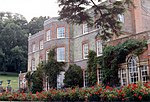Brading railway station
BradingDfT Category F2 stationsFormer Isle of Wight Railway stationsGrade II listed buildings on the Isle of WightIsland Line railway stations (Isle of Wight) ... and 3 more
Railway stations in Great Britain opened in 1864Railway stations on the Isle of WightUse British English from November 2016

Brading railway station is a Grade II listed railway station serving Brading on the Isle of Wight, England. It is located on the Island Line from Ryde to Shanklin. Owing to its secluded countryside location, it is one of the quietest stations on the island.
Excerpt from the Wikipedia article Brading railway station (License: CC BY-SA 3.0, Authors, Images).Brading railway station
Station Road,
Geographical coordinates (GPS) Address Nearby Places Show on map
Geographical coordinates (GPS)
| Latitude | Longitude |
|---|---|
| N 50.678 ° | E -1.139 ° |
Address
Station Road
PO36 0DY
England, United Kingdom
Open on Google Maps









